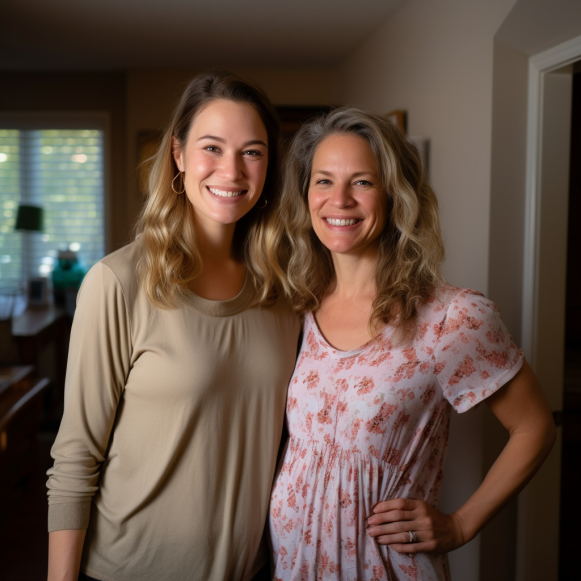No longer just “hippie” moms-to-be: More women delivering babies at home with midwives

Midwifery offers a cheaper alternative to traditional hospitals
Eileen Fruithandler had her second child at home with a midwife in 1992, during a time when she and her late husband faced opposition from family and friends.
“I’m lying to everyone – I had to lie,” the 66-year-old Denver resident, who divides his time between Denver and Palm Beach, Fla., explained. “It wasn’t in vogue when I did it.”
More pregnant mothers-to-be of all ages, backgrounds, and income levels have followed Fruithandler’s path of using midwives in the three decades since her secretive delivery.
According to the Centers for Disease Control and Prevention, the number of women who gave birth at home increased by 12% between 2020 and 2021, reaching “the highest level since at least 1990” with more than 51,600 births. And, from 2016 to 21, more certified midwives — who have historically faced misconceptions about their education and care — have joined the profession to meet the increased demand.
“We’ve done home births in RVs,” Jen Anderson-Tarver, a certified professional midwife at Denver’s New Leaf Midwifery, said. “We’ve done home births in 300-square-foot apartments, and we’ve done home births in $3 million houses.”
Midwives in Colorado are seeing an increase in demand for their services, particularly following the COVID-19 pandemic. According to Anderson-Tarver, the practice is growing because it provides individualized “high-touch” care, a more flexible timeline for birthing, a comfortable setting, access to postpartum care, and a less expensive alternative to hospitals.
Her services for birth, prenatal, and postpartum care average around $5,000. According to the Denver nonprofit The Center for Improving Value in Health Care, the average vaginal delivery in a Colorado hospital costs close to $10,000, while a caesarean-section costs around $14,000.
However, costs vary greatly depending on location, particularly in mountain towns, with a C-section costing as much as $40,600 at Valley View Hospital in Glenwood Springs, according to the nonprofit.
The state’s caesarean rate is approximately 27%, while Anderson-Tarver’s is approximately 5%. The World Health Organization suggests a rate of 10% to 15%.
Midwifery has been practiced since the Paleolithic era. According to Oregon Health and Science University, “midwifery was the most common practice for pregnancy care and childbirth in the early nineteenth century.”
Midwives were stereotyped as “lower class” before the rise of anesthesia and the formal education of male doctors in childbirth. Today, “Canada and the United States are some of the only developed nations with more OB-GYN doctors than midwives,” and Australia and Sweden top the charts for the most midwives per capita, according to data gathering platform Statista.
Certified nurse-midwives – or registered nurses with midwifery training who primarily work in hospitals – and certified professional midwives with training and education to work in out-of-hospital settings make up the practice.
Anderson-Tarver cites two events that have contributed to recent increases in home births: the 2008 documentary “The Business of Being Born,” and the pandemic. As COVID kept hospitals overcrowded, some expecting mothers didn’t want to increase their risk of infection by wearing masks during birth, she explained.
She’s also noticed “a movement” in the insurance industry to provide expanded coverage for home births in recent years.
According to Adela Flores-Brennan, the state’s Medicaid director, Health First Colorado, Colorado’s Medicaid program for low-income health coverage, covers home births performed by enrolled physicians or certified-nurse midwives, but it does not enroll or reimburse certified professional midwives as providers.
However, she stated in a statement that the department is investigating policy regarding the practice of certified professional midwives and their model of care in all birth settings.
New Leaf Midwifery
Anderson-Tarver began her career as a doula, a professional who provides emotional support to mothers and is often confused with a midwife, at a Minneapolis public hospital. After attending over 100 labors, the positive experience of her first home birth inspired her to pursue a career as a midwife.
Anderson-Tarver was drawn to it “out of a love for women empowerment,” and she completed over three years of schooling, an eight-hour board exam, and a four-hour skills exam before completing her registration and licensing in Colorado 12 years ago.
She brings medical supplies to a home birth, such as gloves, catheters, oxygen, suturing equipment, and IVs – “everything that they have at a community birth center.”
She’ll let clients create their own environments by playing music, inviting loved ones to support them, or napping with their partners.
“You would be surprised at the people who are birthing at home,” she said, “from Catholic families, to people who do not identify as female and are birthing, to polyamorous families, to traditional heterosexual relationships.”
Whitney Ford, 36, and her husband, Damien, have always wanted a large family. She was a mother of four in Aurora who described her first birth as “traumatic.”
Ford, then 25, experienced complications while giving birth to her son, Landon, over a 38-hour period in the hospital, resulting in a C-section.
“Nothing went right,” Ford admitted. “As a first-time mom, I didn’t really get the voice that I felt like I deserved.”
It cost $10,000 up front, then “bills upon bills” arrived. “‘Oh, my gosh, they’re charging me for warming the blankets?'” “I wish I had known,” she admitted.
Ford later described herself as “genuinely afraid to have another baby,” so she sought the services of a midwife for her second pregnancy at the age of 31.
But, once again, complications landed her in the hospital for another C-section for her daughter, Elaina. “My dreams of having a home birth were pretty much shot, I thought,” she went on to say.
Given her two C-sections, she qualified as a “very high risk” pregnancy with her third child at the age of 33, but she pleaded with her doctor for a hospital vaginal birth. He gave her one hour to deliver her child before they decided on another surgical delivery.
Ford puked and pushed so hard that Melissa was born within minutes.
She went to Anderson-Tarver for a home birth during her fourth pregnancy at the age of 35, despite the concerns of her relatives and in-laws.
Juliana was born in her bedroom within six hours, with Anderson-Tarver using both of her hands to assist when the infant became stuck during the process.
“I felt like I was giving birth to my baby with my aunt or my sister,” said Ford.
She called the midwife option, which costs $6,000, “the cheapest way to have a baby,” but “I got care as if I’d paid $1 million.”
Paying (and bartering) for midwifery
Samantha Venn, a certified professional midwife at Meadowsweet Midwifery in Lakewood, is part of a two-woman team that serves the Denver area.
“In Colorado, midwives are able to do full prenatal care, full postpartum care, including newborn care up to six weeks,” she went on to say. “We do all normal lab tests within our office,” they say, only referring ultrasounds outside of their facility.
“From lawyers and doctors to stay-at-home moms who live on farms,” she said, their clientele is diverse. “You’d never realize that your neighbor had a birth right next to you.”
And they’re choosing home birth for a variety of reasons, including the fact that they were born at home, were “deeply traumatized” by hospital births, or experienced losses such as miscarriages.
Venn estimates that their typical clientele is in their early-to-mid-30s, because “a lot of first-time moms are waiting a little bit longer to have babies.” However, they’ve helped first-timers as old as their mid-40s and as young as teenagers, which resonates with Venn, who was once a teen mom herself.
Meadowsweet Midwifery charges on the higher end of Denver’s average price range of $4,000 to $7,000, but they offer a sliding scale with discounts for early payments and repeat clients.
They’ve even bartered their services for payment. Farmers “traded us a good chunk of the fee for organic produce and firewood” in 2021, and another client “traded us a good chunk of the fee for website design services and headshots” this year.
“We have done births for just about nothing for clients who are deeply in need,” Venn went on to say. “We just try to meet people where they’re at.”
“Such a peaceful birth”
After the birth of her eldest child, Sara, went poorly at a hospital, Fruithandler decided to use a midwife for the delivery of her second daughter, Danielle, in 1992.
She planned a natural birth without medication at the age of 32, but complications occurred just before Fruithandler’s water broke.
“So fast, they stuck the needle in my back,” she told me. “I delivered the baby via caesarean section, and they cut you open.” It was truly dreadful.”
Following that, she struggled with postpartum depression, which went undiagnosed for months. Fruithandler desired a different outcome for her 34th pregnancy.
In the 1990s, she described herself as a “hippie” and took classes with a nurse midwife with her late husband, a chiropractor. Fruithandler’s decision was made when the midwife mentioned her childhood spent on a farm delivering baby animals.
“This woman’s been doing home births her whole life,” she went on to say.
Her best friend, parents, in-laws, and even neighbors were all against it. “If I did talk to other people about it, they said, ‘No,'” Fruithandler explained.
Fruithandler was still waddling around pregnant two weeks after her due date. Her nurse midwife recommended “sex and walking” to induce labor, and it worked.
Throughout her labor, the nurse midwife and another nurse studying midwifery took turns sleeping at her house.
When Fruithandler began to give birth to her daughter in her bed, the midwife noticed a potentially fatal problem: the cord had wrapped around the baby’s neck. As the infant’s head popped out, she unwrapped it with her fingers.
“Danielle would have died at home, had she got choked by the cord and the midwife didn’t know that,” she went on to say. “A nurse midwife checks on everything.”
A healthy baby delivered at home costs $3,200. She is now a mother of three, having given birth to her son, Austin, at the age of 36.
Despite the fact that “I don’t think it’s for everyone,” she described the at-home birth as “such a peaceful birth.”
Factors to consider
While home birth is “available for people who are low risk,” Dr. Jessica Anderson, director of midwifery and women’s health services at the University of Colorado Anschutz Medical Campus, notes that “people who shouldn’t or can’t birth out of the hospital,” such as those with medical conditions such as high blood pressure or diabetes, should not or can’t give birth at home.
The American College of Obstetricians and Gynecologists advises against home birth for people who have had C-sections, pregnancies with multiple babies, or when a baby moves into an unusual position.
Anderson stated that midwifery is “more visible” today, with a public debate raging about using midwifery to reduce “our rising maternal mortality rate or rising caesarean section rate.”
She cites an increase in enrollment in their midwifery program over the years as it transitioned to a “more accessible” hybrid model that allows educators to teach students in rural communities, different states, and other locations.
Joy Frazer, a certified professional midwife at Joy of Life in Durango, serves three rural counties in southwestern Colorado – Montezuma, La Plata, and Archuleta – as well as San Juan County in northwestern New Mexico. She travels for an hour in three different directions to see her clients on a regular basis.
“Very few midwives” practice in the Four Corners region right now, she says, with only three. There are also fewer hospitals in the rural area.
“We’re limited in that way,” Frazer admitted. If a hospital cannot be reached within 30 minutes, “then our clients have to be comfortable with that, as far as the emergency care plan.”
According to her, the most common reason for transferring care from homes to hospitals is “a first-time mom having a long labor, who’s getting kind of exhausted,” and seeking medications such as an epidural or oxytocin.
“There’s been a lot of propaganda for many decades that a hospital’s safe and midwives are untrained and not experienced and don’t know what they’re doing,” she told me.
She charges $5,200 for birth, prenatal, and postpartum care, as well as four postpartum visits, plus a $200 travel fee for clients who live outside of La Plata County.
“If you’re a home birth midwife practicing alone,” said Jennifer Barr of the Colorado Midwives Association, “the schedule is quite grueling.” “You’re on call 24/7 for large swathes of time.”
Midwives have a smaller clientele base than a birth center or group practice, “but it is not an easy job.”
First-time moms
Natalie Baca, a BIPOC certified professional midwife at Holding Light Midwifery in Arvada, has noticed “more younger or first-time moms looking into home birth,” which she attributes in part to YouTube videos of home births.
Baca worked as a surgical technologist for over two decades, and her experience in a hospital shaped her understanding of the distinction between medical emergencies and non-emergencies.
“There’s so much fear around birth,” she said. But, “truly, emergency C-sections happen really rarely.”
“I actually hemorrhaged with him,” Baca said of giving birth to her son at home in water over a 24-hour period. “My midwife was on top of it.” She took care of me; I had no idea I was bleeding.”
Her service fee is $8,500, but “most people can’t afford that,” so she charges a $5,000 cash discount instead, and can sometimes bill insurance for the difference.
Baca assisted 31-year-old Johnstown resident Nichole Wolfe in giving birth to her first child, Wade, in May.
Wolfe attended a hot yoga class with dimmed lights and lit candles a month after marrying Spencer last July, thinking, “This is how I want to bring a baby into the world” – not realizing she was already pregnant.
During her labor, Wolfe ate breakfast burritos and berries, showered, and even ordered Amazon packages – all while enduring contractions.
“Pain never was a problem for me – it was more, like, getting exhausted,” she told me.
Wolfe settled into the birthing tub in her living room, in front of a crackling fireplace, as rain fell outside. Until she gave birth to their son, her husband alternated between offering her a towel, orange juice, and water.
“It was just the perfect setup,” said Wolfe. “I give credit to women who do it in the hospital because I don’t know how you’re doing it.”
The couple’s insurance “pretty much covered the entire home birth” at $5,000, leaving them with about $500 to pay.
She has since encouraged her friends to give home birth a try. The practice is no longer limited to “hippie” mothers, though “I think now the term they’re using is ‘crunchy,'” Wolfe joked.
Would she have a home birth again if she had more children? “Oh, hell yeah,” Wolfe responded.





